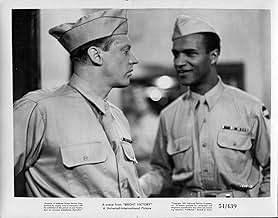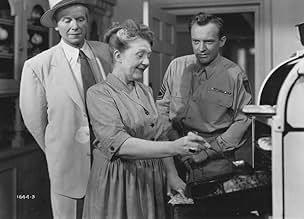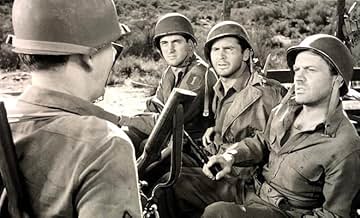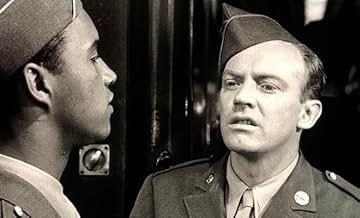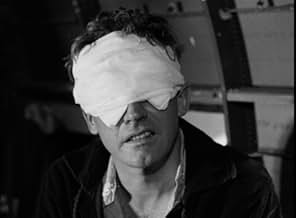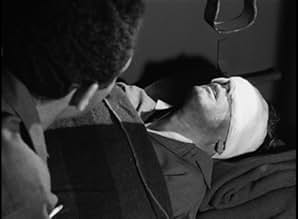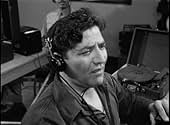ÉVALUATION IMDb
7,3/10
1,1 k
MA NOTE
Ajouter une intrigue dans votre langueAfter he gets blinded by a German sniper's bullet in 1943, Sergeant Larry Nevins begins the long and painful road to recovery.After he gets blinded by a German sniper's bullet in 1943, Sergeant Larry Nevins begins the long and painful road to recovery.After he gets blinded by a German sniper's bullet in 1943, Sergeant Larry Nevins begins the long and painful road to recovery.
- Nommé pour 2 oscars
- 5 victoires et 6 nominations au total
Julie Adams
- Chris Paterson
- (as Julia Adams)
Avis en vedette
This film was partially filmed on location at Valley Forge General Hospital (and NOT at the actual Valley Forge), in Phoenixville, PA. This hospital was a center for rehabilitating blind soldiers during World War II. Every enlisted man assigned to Valley Forge Gen. Hosp. after 1952 was shown this film as part of their orientation to the hospital.
Some of the interior and exterior shots were done at the hospital. The scenes where the soldier walks toward blank walls was done at the outdoor handball courts at the hospital. Several ward scenes were also shot there.
It was nice to see medics portrayed as something other than just battlefield personnel.
I would love to have a video of this film, but such is not available.
Well acted, and reasonably realistic.
Some of the interior and exterior shots were done at the hospital. The scenes where the soldier walks toward blank walls was done at the outdoor handball courts at the hospital. Several ward scenes were also shot there.
It was nice to see medics portrayed as something other than just battlefield personnel.
I would love to have a video of this film, but such is not available.
Well acted, and reasonably realistic.
Of course I always loved Bright Victory, since my dad was one of the blinded veterans used as extras in the movie. I remember him telling me that Kennedy had dark contacts in, and would yell out to remove them as soon as a scene was over.My dad said he felt like calling out, "But I can't remove mine!" It is a wonderful story of many blinded vets, particularly at that time. A captain was accompanying my dad and another blind soldier, who happened to be black, to their homes in GA. When they came to the train station in DC, they were informed that the black man could no longer ride in the same car. Both the captain and my dad were outraged for this soldier who had also gave his sight for his country. A new car was added to the train, and the 3 soldiers had it all to themselves. I was proud of my dad and the captain for taking that stand. They are deceased, but the lesson of the train, and the lesson of "Bright Victory" are both stories I pass on to my child and to my students over 32 years.
I stumbled upon this excellent and compelling film during AMC's "Veterans' Day Movie Marathon." Dealing with a soldier's (Arthur Kennedy) rehabilitation after losing his sight during WWII in surprisingly frank ways for its time (released in 1951), this seems to me to be the first time I saw raw racism and its consequences in a film. A superb love story on the surface, it's the underlying themes of classism, racism and realistically dealing with the handicapped which set it a notch above the terrific 1946 film, "The Best Years of our Lives." Face it, Harold Russell, while a hero, was no actor. The electricity between Kennedy and his new "friend" (played by Peggy Dow ~ whatever became of this talented actress? Her career lasted only 4 years) is remarkable. Happy ending doesn't detract.
What is really interesting about this movie, is the "race" issues it addresses and for the time in which it was made, that is rather remarkable.
The Nevins character is a good old boy from the South and openly expresses his racism. The first time is when he's on the plane headed back to the states and a black soldier sits next to to him. They're both from Florida start talking. Nevins asks him if he knows the country club and the guys says he served tables at it. Nevins now realizes the guy is black and immediately calls over a nurse to sit by him.
The next time is in the rehabilitation hospital. Nevins accidentally walks into a black soldier, also blind. All Nevins recognizes is the man's southern accent and offers to buy him a drink. They become "friends" and hang out together. Then one day, the other blind soldiers mention there are some new patients coming into their ward and Nevins pops off, "Yeah, and I heard 3 of them are (uses the "N" word)". The black guys just stops in his tracks now realizing how his new friend really thinks and feels.
The other blind white soldiers already knew the guy was black and remarked "Maybe he thought you were colored too".
Later on Nevins goes home and is with his parents, who are equally racist. Nevins starts to "see" the errors of his ways/thinking. There is a bit of justification from the father that that was how they were brought up, etc., but for 1951 it is amazing they were even addressing such things let alone using the "N" word.
The Nevins character is a good old boy from the South and openly expresses his racism. The first time is when he's on the plane headed back to the states and a black soldier sits next to to him. They're both from Florida start talking. Nevins asks him if he knows the country club and the guys says he served tables at it. Nevins now realizes the guy is black and immediately calls over a nurse to sit by him.
The next time is in the rehabilitation hospital. Nevins accidentally walks into a black soldier, also blind. All Nevins recognizes is the man's southern accent and offers to buy him a drink. They become "friends" and hang out together. Then one day, the other blind soldiers mention there are some new patients coming into their ward and Nevins pops off, "Yeah, and I heard 3 of them are (uses the "N" word)". The black guys just stops in his tracks now realizing how his new friend really thinks and feels.
The other blind white soldiers already knew the guy was black and remarked "Maybe he thought you were colored too".
Later on Nevins goes home and is with his parents, who are equally racist. Nevins starts to "see" the errors of his ways/thinking. There is a bit of justification from the father that that was how they were brought up, etc., but for 1951 it is amazing they were even addressing such things let alone using the "N" word.
10g2608671
I first saw this movie as a kid in the early 60's at my dad's suggestion. He wanted me to pay attention to the real story, that being that racism has no place in a free society. I did pay attention, and to this day, his instance that I watch the movie for content is among the fondest memories I have of my Dad. He taught me how to hunt, fish, drive a car, paint a house and respect people. It is all the more remarkable, especially since I grew up in an all white town in western PA. Also, I now live no more than a few hundred yards where the movie was made. The former VF Army Hospital is now mostly under the ownership of the VF Christian College - a great resource and an asset to our community. When my family moved here some 20 years ago, we immediately discovered the "old army base" and I frequently took our kids there to walk, play on the falling down miniature golf course and just try to imagine what the facility was like when it was in use (swimming pool, gymnasium, small duck pin bowing alley, full size golf course and two fishing ponds)-- and what the presence of the base meant to Phoenixville then. I actually played handball on that court that Artuhr Kennedy is tested on for obstacle perception. The facility specialized in head and eye injuries and had a very substantial psychiatric ward as well. Anyhow, along with the anti-racism message umbered in the movie, I enjoy the scenes of the old hospital and reflect on what it looks like now. And of course,-- the scenes of old Phoenixville, although way before my time, bring a sense of nostalgia to me that is hard to describe not being a native of the area. None the less, it's there. As an aside, for anyone who is interested; Phoenixville is where they filmed The Blob with Steve McQueen -- the Colonial theater still stands to this day and has become a landmark. Oddly enough, McQueen and Kennedy would appear together in Nevada Smith years later. It is indeed a small world.
Le saviez-vous
- AnecdotesTen blind WWII veterans at the hospital appeared as extras and were advisers for this film.
- GaffesThe locomotive pulling the train when Joe arrives home in Florida was not produced by American Locomotive Company until 1950, seven years after the actual event. Diesel locomotives were not used on local trains until after the war years.
- Citations
Larry Nevins: I told ya i wanted security, remember... well I was looking for it in all the wrong places. Nobody can ever give it to you Judy. That way, it costs too much, you gotta make it for yourself.
Meilleurs choix
Connectez-vous pour évaluer et surveiller les recommandations personnalisées
- How long is Bright Victory?Propulsé par Alexa
Détails
- Date de sortie
- Pays d’origine
- Langue
- Aussi connu sous le nom de
- Bright Victory
- Lieux de tournage
- société de production
- Consultez plus de crédits d'entreprise sur IMDbPro
- Durée
- 1h 37m(97 min)
- Couleur
- Rapport de forme
- 1.37 : 1
Contribuer à cette page
Suggérer une modification ou ajouter du contenu manquant

